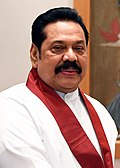Background
In an attempt to end the Sri Lankan Civil War the Indo-Lanka Accord was signed on 29 July 1987. One of the requirements of the accord was that the Sri Lankan government to devolve powers to the provinces. [1] Accordingly, on 14 November 1987 the Sri Lankan Parliament passed the 13th Amendment to the 1978 Constitution of Sri Lanka and the Provincial Councils Act No 42 of 1987. [2] [3] On 3 February 1988 nine provincial councils were created by order. [4] The first elections for provincial councils took place on 28 April 1988 in North Central, North Western, Sabaragamuwa, and Uva provinces. [5] On 2 June 1988 elections were held for provincial councils for Central, Southern and Western provinces. The United National Party (UNP), which was in power nationally, won control of all seven provincial councils.
The Indo-Lanka Accord also required the merger of the Eastern and Northern provinces into one administrative unit. The accord required a referendum to be held by 31 December 1988 in the Eastern Province to decide whether the merger should be permanent. Crucially, the accord allowed the Sri Lankan president to postpone the referendum at his discretion. [1] On September 2 and 8 1988 President Jayewardene issued proclamations enabling the Eastern and Northern provinces to be one administrative unit administered by one elected council, creating the North Eastern Province. [4] Elections in the newly merged North Eastern Province were held on 19 November 1988. The Eelam People's Revolutionary Liberation Front, an Indian backed paramilitary group, won control of the North Eastern provincial council.
On 1 March 1990, just as the Indian Peace Keeping Force were preparing to withdraw from Sri Lanka, Annamalai Varadaraja Perumal, Chief Minister of the North Eastern Province, moved a motion in the North Eastern Provincial Council declaring an independent Eelam. [6] President Premadasa reacted to Permual's UDI by dissolving the provincial council and imposing direct rule on the province.
The 2nd Sri Lankan provincial council election was held in 1993 in seven provinces. The UNP retained control of six provincial councils but lost control of the largest provincial council, Western, to the opposition People's Alliance. A special election was held in Southern Province in 1994 after some UNP provincial councillors defected to the opposition. The PA won the election and took control of the Southern Provincial Council.
The 3rd Sri Lankan provincial council election was held in 1999 in seven provinces. The PA, which was now in power nationally, managed to win the majority of seats in two provinces (North Central and North Western). It was also able to form a majority administration in the other five provinces with the support of smaller parties such as the Ceylon Workers' Congress (CWC) . The UNP regained control of the Central Provincial Council in 2002 after the CWC councillors crossed over to the opposition. [7]
The 4th Sri Lankan provincial council election was held in 2004 in seven provinces. The United People's Freedom Alliance (UPFA), the successor to the PA, won all seven provinces.
On 14 July 2006, after a long campaign against the merger, the JVP filed three separate petitions with the Supreme Court of Sri Lanka requesting a separate Provincial Council for the East. [4] On 16 October 2006 the Supreme Court ruled that the proclamations issued by President Jayewardene were null and void and had no legal effect. [4] The North Eastern Province was formally demerged into the Northern and Eastern provinces on 1 January 2007.
The 5th Sri Lankan provincial council election was held on a staggered basis during 2008/09 in eight provinces including the newly demerged Eastern Province. The UPFA won all eight provinces.
The 6th Sri Lankan provincial council election was also held on a staggered basis during 2012-14 in eight provinces, including in the Northern Province for the first time in 25 years. Elections were held on 8 September 2012 in Eastern, North Central and Sabaragamuwa provinces. The UPFA won the majority of seats in two provinces (North Central and Sabaragamuwa) and was also able to form a majority administration in Eastern Provinces with the support of the Sri Lanka Muslim Congress. Elections were held on 21 September 2013 in Central, Northern and North Western provinces. The UPFA won the majority of seats in two provinces (Central and North Western) whilst the Tamil National Alliance won in the Northern Province. [8] [9] [10] Southern Provincial Council and Western Provincial Council were dissolved by their governors on 12 January 2014. [11] [12]
This page is based on this
Wikipedia article Text is available under the
CC BY-SA 4.0 license; additional terms may apply.
Images, videos and audio are available under their respective licenses.


